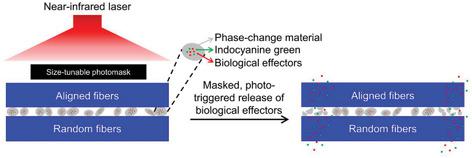当前位置:
X-MOL 学术
›
Small Methods
›
论文详情
Our official English website, www.x-mol.net, welcomes your feedback! (Note: you will need to create a separate account there.)
Spatiotemporally Controlling the Release of Biological Effectors Enhances Their Effects on Cell Migration and Neurite Outgrowth
Small Methods ( IF 12.4 ) Pub Date : 2020-07-01 , DOI: 10.1002/smtd.202000125 Jiajia Xue 1 , Tong Wu 1 , Jichuan Qiu 1 , Younan Xia 2
Small Methods ( IF 12.4 ) Pub Date : 2020-07-01 , DOI: 10.1002/smtd.202000125 Jiajia Xue 1 , Tong Wu 1 , Jichuan Qiu 1 , Younan Xia 2
Affiliation

|
It is a major challenge to coordinate topographic cues from scaffolds with the on‐demand, sustained release of biological effectors to maximize their performance in tissue regeneration. Here, a system involving masked, photo‐triggered release of biological effectors from a temperature‐sensitive scaffold for augmented cell migration and neurite outgrowth is reported. The scaffold contains microparticles of a phase‐change material (PCM) sandwiched between two layers of electrospun fibers. The biological effectors are co‐loaded with a photothermal dye in the PCM microparticles. Under irradiation with a near‐infrared laser, the PCM will be melted to swiftly release the biological effectors. By imposing a photomask between the scaffold and the laser, only those microparticles in the irradiated region are melted, enabling a spatial control over the release. By adjusting the photomask, different regions of the scaffold can be sequentially irradiated at designated times, realizing on‐demand and sustained release of the biological effectors with spatiotemporal controls. In one demonstration, this method is used to accelerate the directional migration of NIH‐3T3 fibroblasts along the uniaxial or radial direction of fiber alignment by controlling the release of epidermal growth factor. In another demonstration, the release of nerve growth factor is managed to significantly promote neurite outgrowth from PC12 cells.
中文翻译:

时空控制生物效应器的释放增强其对细胞迁移和神经突生长的影响
将支架的地形线索与生物效应器的按需持续释放相协调,以最大限度地提高其在组织再生中的性能是一项重大挑战。在这里,报道了一种系统,该系统涉及从温度敏感支架中掩蔽、光触发释放生物效应器,以增强细胞迁移和神经突生长。该支架含有夹在两层电纺纤维之间的相变材料(PCM)微粒。生物效应器与 PCM 微粒中的光热染料共同负载。在近红外激光照射下,PCM会熔化,迅速释放生物效应器。通过在支架和激光之间施加光掩模,只有照射区域中的那些微粒被熔化,从而能够对释放进行空间控制。通过调整光掩模,可以在指定时间顺序照射支架的不同区域,实现时空控制的生物效应物的按需持续释放。在一项演示中,该方法用于通过控制表皮生长因子的释放来加速 NIH-3T3 成纤维细胞沿着纤维排列的单轴或径向方向的定向迁移。在另一个演示中,神经生长因子的释放可显着促进 PC12 细胞的神经突生长。
更新日期:2020-07-01
中文翻译:

时空控制生物效应器的释放增强其对细胞迁移和神经突生长的影响
将支架的地形线索与生物效应器的按需持续释放相协调,以最大限度地提高其在组织再生中的性能是一项重大挑战。在这里,报道了一种系统,该系统涉及从温度敏感支架中掩蔽、光触发释放生物效应器,以增强细胞迁移和神经突生长。该支架含有夹在两层电纺纤维之间的相变材料(PCM)微粒。生物效应器与 PCM 微粒中的光热染料共同负载。在近红外激光照射下,PCM会熔化,迅速释放生物效应器。通过在支架和激光之间施加光掩模,只有照射区域中的那些微粒被熔化,从而能够对释放进行空间控制。通过调整光掩模,可以在指定时间顺序照射支架的不同区域,实现时空控制的生物效应物的按需持续释放。在一项演示中,该方法用于通过控制表皮生长因子的释放来加速 NIH-3T3 成纤维细胞沿着纤维排列的单轴或径向方向的定向迁移。在另一个演示中,神经生长因子的释放可显着促进 PC12 细胞的神经突生长。


























 京公网安备 11010802027423号
京公网安备 11010802027423号